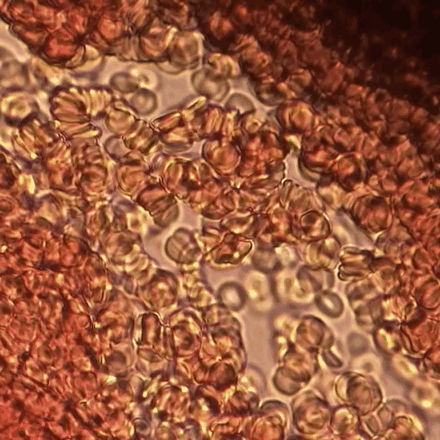Playlist
Show Playlist
Hide Playlist
Polycythemia – Red Cell Disorders
-
Slides Disorders of red cells.pdf
-
Download Lecture Overview
00:01 We spent a lot of time talking about anaemia. I just want to finish off by introducing the other side of the coin where the patient has too many red cells. In that, we call polycythaemia. 00:14 Here we see an increase in the haemoglobin concentration. It makes the blood more difficult to pump around the body, it is more viscous and complications here include blood clots, tiredness, lethargy and also pruritus or itching, which is particularly seen in polycythaemia vera. So I will explain in a minute. On the right is a nice diagram to explain how to diagnose polycythaemia. One of the common problems that we encounter. On the left, we see normal constituents of blood and red is the red cell mass and in blue is the plasma volume and of course we are looking at the haemoglobin concentration and it depends on the relative amount of those, but on the left is the normal range. In the middle is somebody with primary polycythaemia that red cell masses definitely increased as you can see above the normal range that plasma volume remains the same. But on the right is a condition where the red cell mass has increased, but actually remains below the normal range, but here we have a reduction in the plasma volume. So actually we think as polycythaemia because the ratio is now normal although there is not actually a true increase in the red cell mass. So if somebody is terribly dehydrated, you may see that sort of picture. 01:49 Let us look at how we classify polycythaemia. Polycythaemia, as you will see on the left, can be diagnosed, classified as either a primary polycythaemia due to a myeloproliferative disorder or secondary to an increase in erythropoietin. Lung disease, smoking, altitude or sometimes a tumour producing a lots of erythropoietin and driving the bone marrow. And on the right is quite a useful algorithm for approaching patients who have potential polycythaemia. 02:26 You can see at the top the potential haematocrit that might make you consider that the patient has polycythaemia and male over 0.52 or female over 0.48. Going down, you can check whether the red cell mass is truly raised or if not, it is an apparent polycythaemia. It the red cell mass is raised or they cause of secondary polycythaemia present. If that is true, it can be a secondary polycythaemia and if not consider polycythaemia vera. Now the management of polycythaemia vera depends on the genetic abnormality of this disorder which we now understand. Almost every patient has a mutation in the JAK2 gene and we can use this to introduce nutrients as well as taking off blood or using drug such as hydroxyurea JAK2 inhibitors, which are all tablets are now being used in this disorder and I will talk more about that in the lecture on myeloproliferative diseases. Secondary polycythemia is best treated by correcting the underlying cause stopping the patients smoking, trying to treat the lung disease, which can you, use phlebotomy taking off blood donations if you need to. 03:58 So In summary, I hope you have seen from the slides that disorders of the red cell are very common within the world. The management of anaemia is dependent on making an accurate diagnosis of the etiology based on targeted treatment, but an excess of red cells can also be dangerous and is just important that we get the diagnosis right in those cases. 04:23 Thank you very much for watching the lecture.
About the Lecture
The lecture Polycythemia – Red Cell Disorders by Paul Moss, PhD, OBE, FMed, FRCPath is from the course Hematologic Disorders.
Included Quiz Questions
Which of the following findings would you expect in a patient with primary polycythemia?
- Increased red cell mass and normal plasma volume
- Decreased red cell mass and normal plasma volume
- Normal red cell mass and normal plasma volume
- Normal red cell mass and decreased plasma volume
- Increased red cell mass and increased plasma volume
Which gene is commonly associated with polycythemia vera?
- JAK2
- Epo
- PML:RARA
- WT1
- p53
Customer reviews
5,0 of 5 stars
| 5 Stars |
|
1 |
| 4 Stars |
|
0 |
| 3 Stars |
|
0 |
| 2 Stars |
|
0 |
| 1 Star |
|
0 |
there is detailed information explained well and there is no any ads





